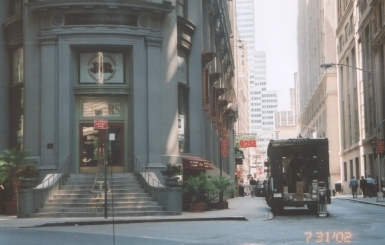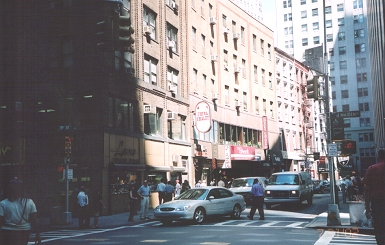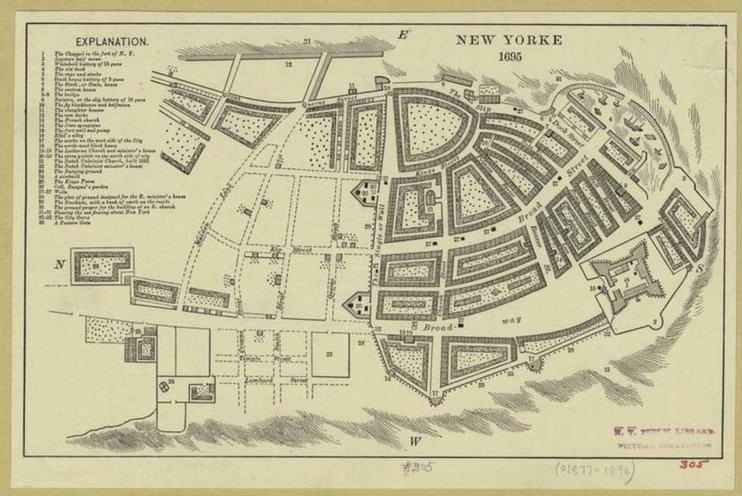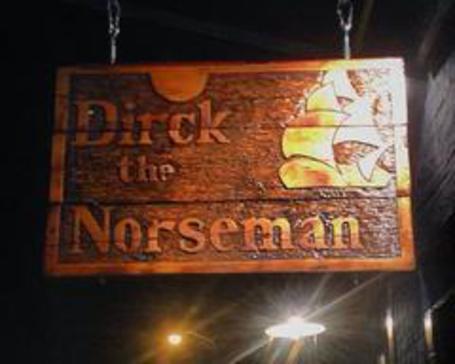The Fulkerson Family Pages
Colonial Days: New Netherlands to New York
On August 4, 1649, Van Tienhoven sold property on the 250 block of Pearl Street to Dirck and their other brother-in-law, Abraham Ver Planck.
The lots the brothers-in-law purchased were about a half-acre each, extending along Pearl Street on the East River to some high ground at the rear, between Maiden Lane on the south and what is now Fulton Street on the north.
Maiden Lane, which still exists, was presumably named after the three maidens whose family originally owned the land: Christina, Maria and Rachel Vigne.
Dirck subdivided his lot into smaller properties, and during the next five years sold most of the lots, with or without a house. The deeds are recorded.
Hage Bruynsen the Swede bought a lot from Dirck in November 1653 and built his own house. (In February 1654 Dirck sued Bruynsen, as he was failing to pay for the property.)
Dirck built himself another new house in 1649 at 259 Pearl Street. In 1651 he sold this home to Roeloff Teunissen - another Swede, from Goteborg, in the employ of the Dutch West India Company as captain of the ship Emperor Charles. Roeloff remained in this home until 1657, selling to Jan Hendricks Steelman. In the transaction conveying his property to Teunissen, Dirck is recorded as being Dirck Holgerson.
The address at 259 Pearl Street was the site of a business in the 19th Century:
A.L. Halsted and Sons, Importers and Dealers in English, German and American Hardware, Cutlery &c
The business billed itself as "the only exclusively cash hardware store in the United States."
Its advertising reminded customers that it was directly across the street from the United States Hotel.
Site of Dirck's first house on Pearl
Street, one block south of Wall Street
Smits Vly in 2002, on NE edge of
New York's financial district.
Imagine it is 1882. You're in New York City, standing on Pearl Street, south of the Fulton Street intersection, on the west side of the street. You'd possibly be standing on Dirck's old front yard.
Just a few feet away you will see Dirck's great-great-great-great-great-great nephew busily at work, constructing the Pearl Street Station, the world's first electric power plant, which will soon light lower Manhattan with his new invention, the incandescent light bulb.
This nephew, laboring only a few feet from his ancestral homeland, not quite two hundred years after its settling, is Thomas Alva Edison.
In 1638 the Indians agreed to allow Dutch settlement in Brooklyn. Our grandfather Dirck Holgerson was one of the first to take advantage of the newly-available lands, receiving a grant to buy 400-500 acres of land at Greenpoint from the Indians--the tract he purchased had a mile-long frontage on the East River and bounded on the south and north sides by Norman Kill and Mespath Kill.
Mespath Kill became Newtown Creek after the British moved into the area and founded the Newtown settlement.
Noorman's Kill later became Bushwick Creek.
The inlet where the creek emptied into the East River, immediately south of Dirck's house still exists.
The northwest point on his East River frontage was known by several names, including Noorman's Point and Woud Hoek (Woodland Point). Years later it was planted with green wheat fields and gained its current name of Greenpoint.
At 7 N 15th St, Brooklyn, NY 11222, looking out over Bushwick Inlet is Greenpoint Beer and Ale, the former Dirck the Norseman brewpub.




